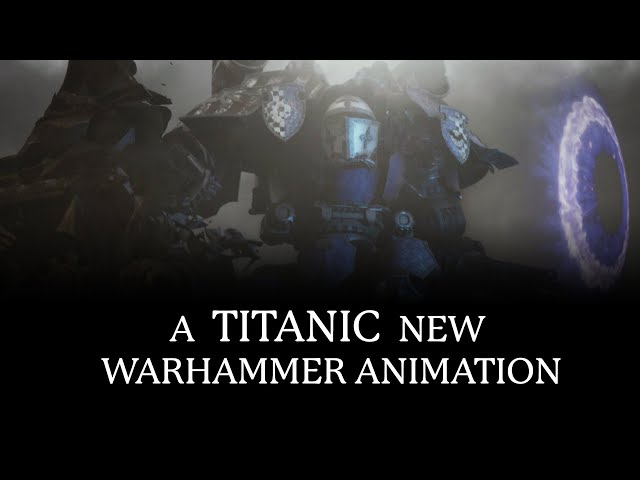Ever since Games Workshop and Amazon announced they were teaming up to create an official Warhammer 40k TV series, with Henry Cavill in a starring role, I’ve been equally eager and apprehensive. How can a TV studio bring the insane scale of conflict in the 41st millennium to life, without blowing through its whole budget in the intro cinematic? A new animation, available via the Warhammer TV subscription service, offers many answers.
Kill Lupercal is a new animation created under the Warhammer Original banner. It’s the first animation to deal exclusively with conflict between Warhammer Titans, colossal bipedal mechs with the armament of a battleship and a mind of their own, and takes place in the dying days of the Horus Heresy, the single greatest conflict in the history of the Warhammer 40k universe.
The first, fifteen minute episode is available on Warhammer TV, which is part of Games Workshop’s fan subscription service Warhammer Plus. I’m a sucker for the Horus Heresy books, I love stompy robots, and I’m already a subscriber, so I’m very much the target audience – I like it, but it’s not a reason to subscribe in and of itself.

Kill Lupercal does an excellent job managing scope, so that a potentially colossal story was actually economical to produce. And that’s relevant for the Warhammer 40k Henry Cavill TV series because, after the big man himself, the main cost facing the show is likely to be CGI effects. Here’s what Kill Lupercal does to keep costs under control:
Focus on the humans
Kill Lupercal has an entirely human cast, so far featuring Titan pilots and the (admittedly heavily modified) Mechanicum tech adepts. There are plenty of alien Warhammer 40k factions, and the more alien they are, the more expensive they will be to put on screen.
There are lots of great Warhammer 40k books where Xenos play a very minor role, so it’s a viable strategy to keep them on the sidelines – and it’ll make them that much more impactful when they do finally appear.
Helmets on
Only the main character in Kill Lupercal is unhelmeted, saving the animation studio time and effort animating faces, something that will hold equally true for live action CGI sequences. Although there’s no way to make massive battles really cheap, at least Space Marine chapters always keep their helmets on.
An added bonus for live action filming is that, if your extras are in helmets, there’s no way for the audience to know you’re re-using the same actor in multiple roles – very useful if you need to do reshoots.
A self-contained set
Over half of Kill Lupercal takes place in a single set, the cockpit of a Warlord Titan. That could be built as a sound stage, which is cheaper and easier to manage than location shooting, and separates the human actors from any really violent action that’s being worked on in CGI. It worked for Star Trek for decades, it could work for 40k.
Shots composed for greenscreen
Several early shots in Kill Lupercal have very clean separations between a human-scale foreground and a background on a far larger scale, such as the massive Titan hanger. This kind of shot composition is fairly easy to replicate with actors on a soundstage filmed against a greenscreen background.
A focus on details
Episode one of Kill Lupercal focuses on the practicalities of getting a Warlord Titan walking, and technicalities of how it operates. There are quite a few conversations and instances of characters fiddling with consoles – which would be relatively cheap to film, certainly compared to fight scenes. When they fit into a plot, these build tension and a sense of place.
Smoke everywhere
There’s a lot of smoke and fog in Kill Lupercal – a time honored way to cover up for a lack of detail in your backgrounds. The original Silent Hill hid the Playstation’s low draw distance behind fog and created a classic horror videogame in the process, and when Ridley Scott was dissatisfied with the (frankly absurd) level of detail on the sets for Blade Runner, he covered the perceived deficiencies with a huge amount of dry ice.
The goal of all these approaches isn’t to make a cheap show per se, it’s to ensure that a limited budget gets spent where it will have the most impact. I’m hoping the rest of Kill Lupercal gives a big payoff!
Are you a film buff who’s spotted other cost-cutting techniques in Kill Lupercal that would work equally well for the live action TV series? Do you just really, really like giant robots? Come and chat in the official Wargamer Discord community!
Kill Lupercal is the first Warhammer Original animation set during the Horus Heresy, but we don’t expect it to be the last – especially since the animation team at Games Workshop has a whole lot of era-appropriate new models, thanks to the trailer for the upcoming Horus Heresy Saturnine box set.
Source: Wargamer




